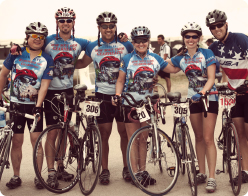Build a Better Diet
Ride stronger with meals from the Mediterranean
In the region where olives flourish, people flourish, too. Heart disease, cancer, diabetes and even Alzheimer's are far less common in Mediterranean countries, such as Greece, Italy, France and Spain. Perhaps this explains why many of the world's best bike racers, including Tour de France winner Alberto Contador, have a nutritional leg up. Eating well is easy for them because "Mediterranean eaters place an emphasis on fresh, quality ingredients," says Cynthia Sass, R.D., C.S.S.D., author of Flat Belly Diet ($16; rodale.com), based on the region's eating patterns. These dishes often build on a few flavor-packed ingredients, such as tomatoes, basil and balsamic vinegar. Follow Sass's advice to import the best of the Mediterranean into your kitchen.
Make Veggies the Centerpiece
Mediterranean meals typically consist of about 75 percent plant matter, from fruits, vegetables, whole grains and beans. "Meat is considered a condiment and is eaten infrequently," says Sass. Greeks, for example, eat little red meat but consume an average of nine daily servings of fruits and vegetables. These proportions offer a broad spectrum of vitamins, minerals and antioxidants, which stave off disease and fuel athletic performance.
Try it Pick a vegetable or fruit and design the meal around it. Pair great berries with oatmeal; mix broccoli into a pasta sauce. Fresh, in-season fruits and veggies deliver the highest nutrient content, and you can save them for other times of the year as well. "Freezing tends to lock in nutrients and preserve them, so many frozen foods are just as nutritious as when they are fresh," says Sass.
Choose Plant-Based Fats
Foods popular in the Mediterranean--like nuts and olive oil--aren't low in fat. But it's monounsaturated fat, the good kind that lowers total cholesterol levels. Plus, several studies have found that the diet fosters weight loss. One 2008 paper published in the New England Journal of Medicine reported that those who switched to a Mediterranean diet lost an average of 9.7 pounds, compared with 6.4 pounds for those who followed a low-fat plan.
Try it Use olive oil in place of butter or mayo and snack on nuts instead of cheese. Slice an avocado into your salad or sandwich.
Season Food Liberally
"Cyclists need more antioxidants in their diets to repair the wear and tear from long rides," says Sass. Mediterranean food is amply seasoned with herbs and spices so packed with antioxidants that even small doses deliver powerful benefits. One teaspoon of cinnamon delivers as many antioxidants as a cup of pomegranate juice.
Try it Add antioxidant-rich herbs and spices such as oregano, cinnamon or dill to entrees. Place lemon slices over fish and beans to make a zingy dish. Grow a windowsill herb garden for a supply of flavor-packed seasonings.
Swap Your Protein
Fish, rather than beef, is the go-to protein, so Mediterranean eaters are consuming more healthy fatty acids than artery-clogging saturated fats.
Try it Sass recommends two or three seafood-based meals per week. Start with the recipe below, which has typical Mediterranean vegetables and fruits (fennel and olives), olive oil and seasonings (lemon and thyme). To make a full meal, Sass says, Mediterraneans would round it out with even more vegetables, such as a salad of beans or greens.
Courtesy of Bicycling Magazine 




















Join Us
FacebookTwitterLinkedInYouTubePinterestMS Connection